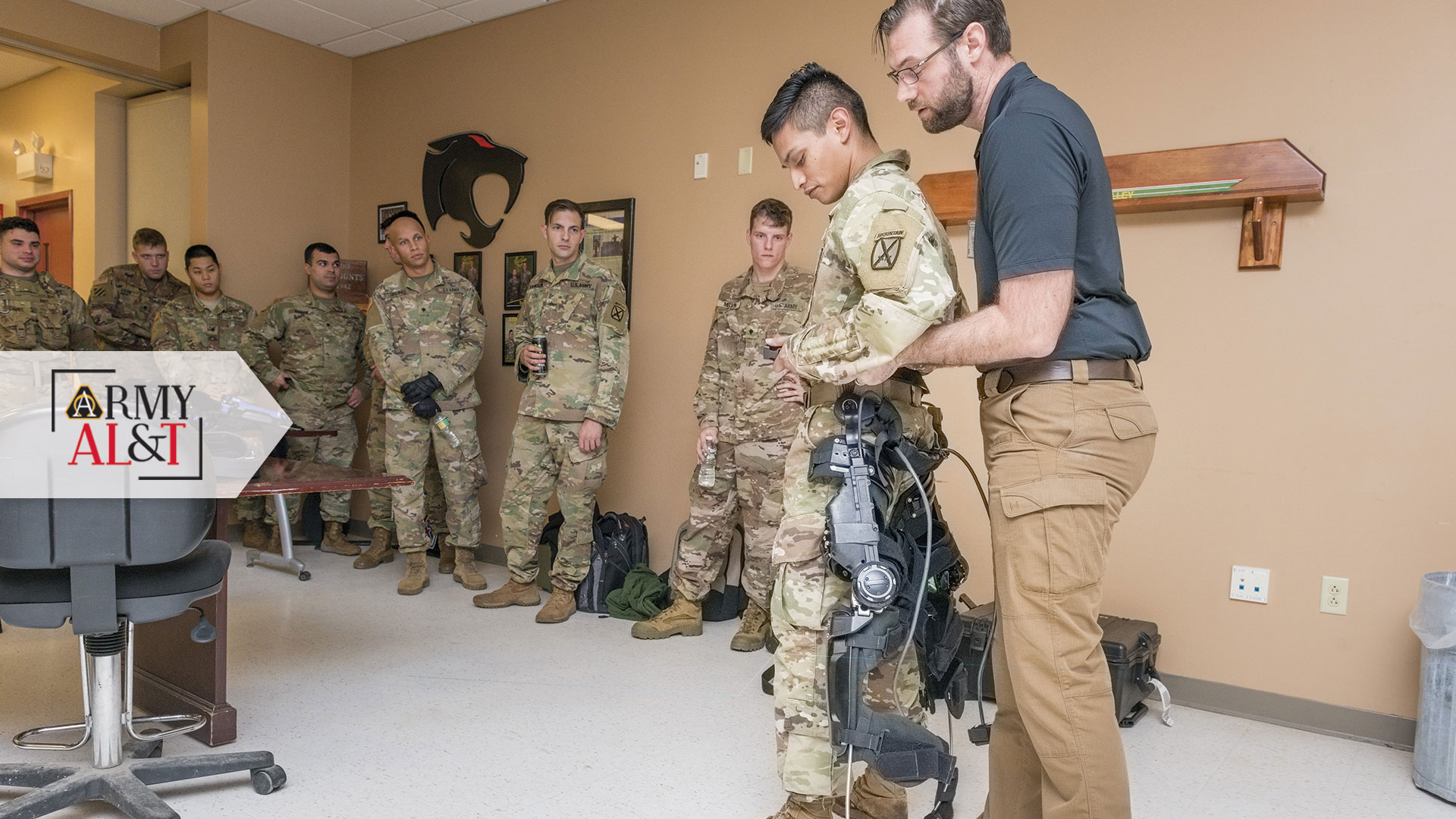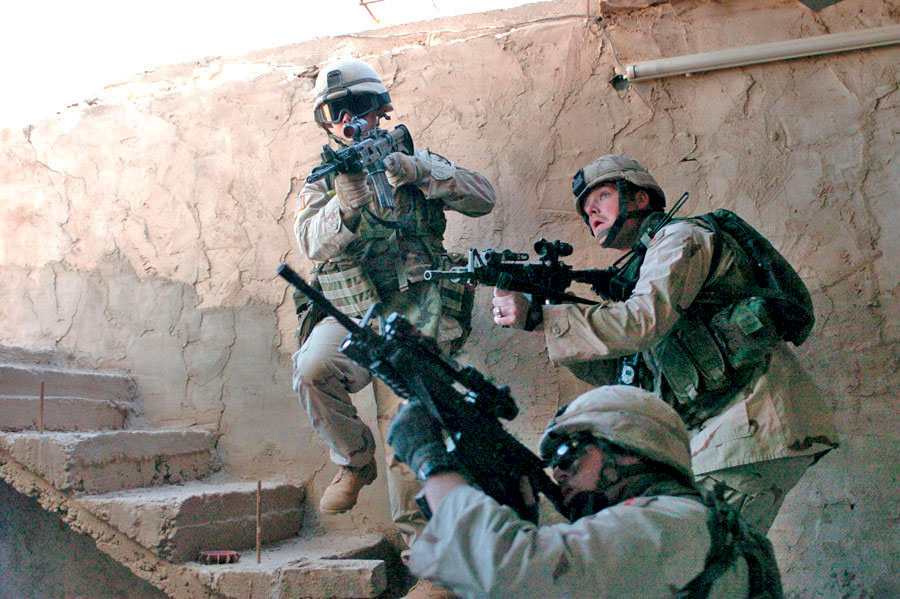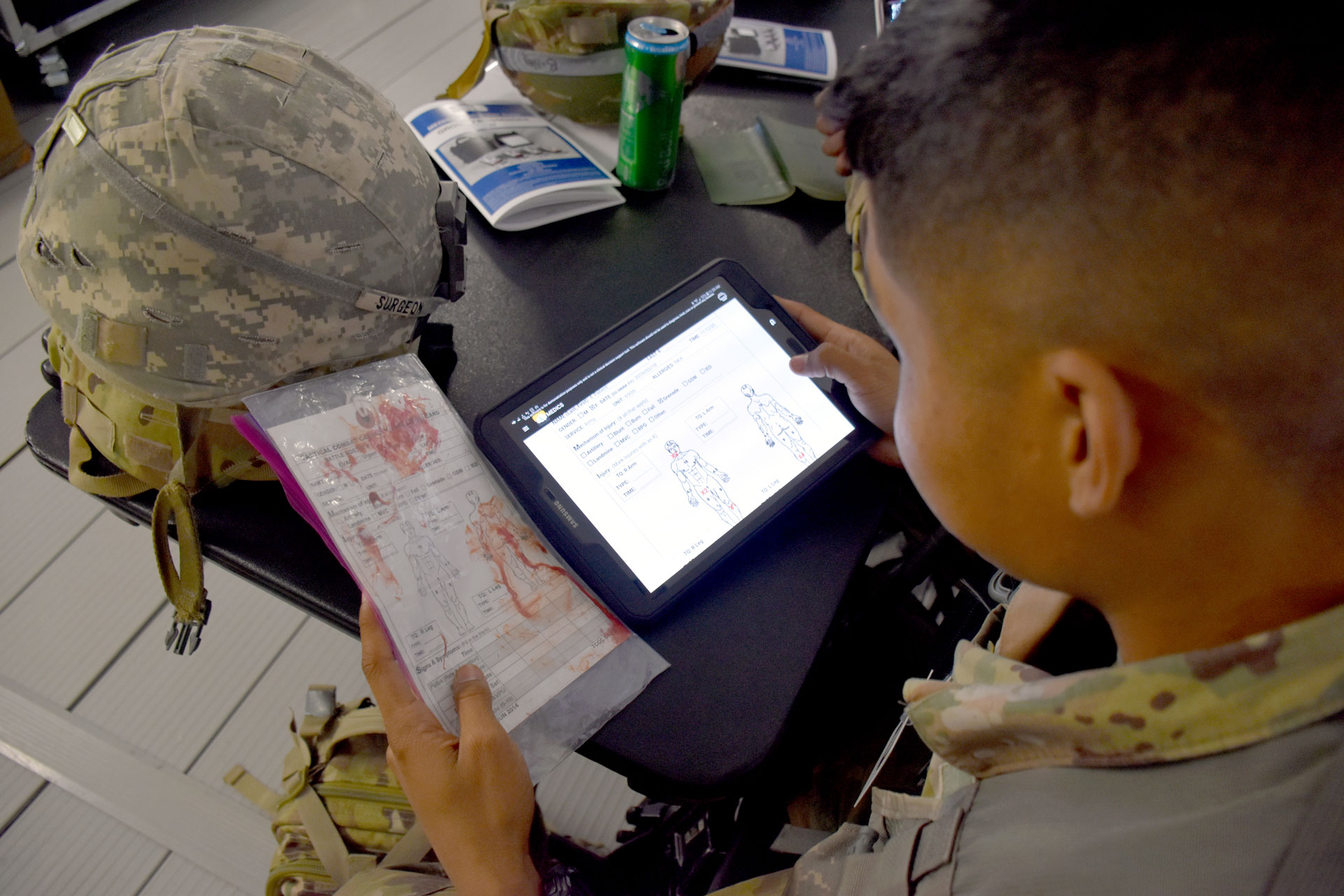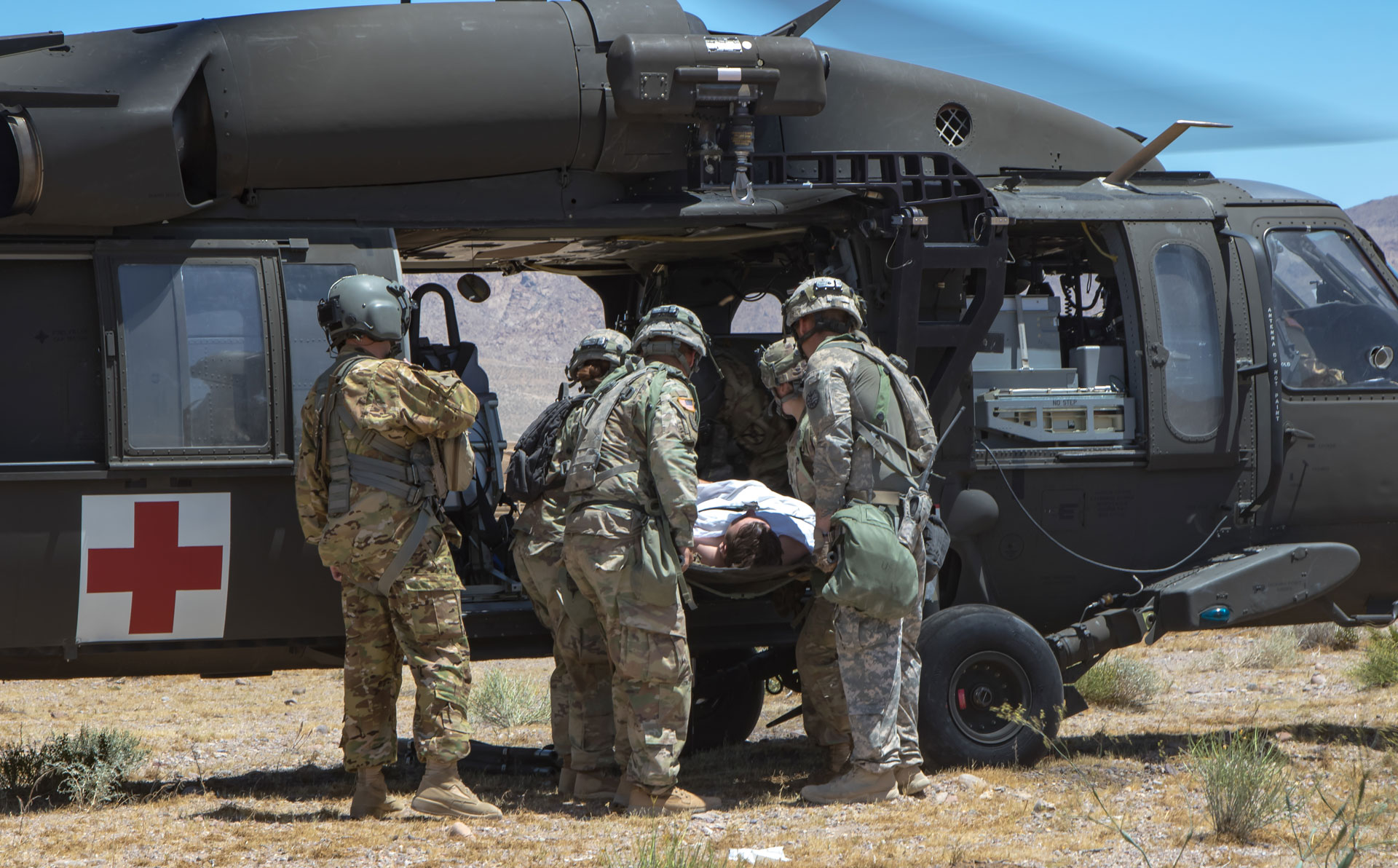
SUPPORTING THE SOLDIER, LITERALLY: For dismounted Soldiers in the field, one of the most common injuries is from carrying nearly 100 pounds of gear for extended periods, often over rough terrain. But exoskeletons like the Human Universal Load Carrier could help the injured warfighter maintain mobility and combat-effectiveness. (Photo by David Kamm, Combat Capabilities Development Command Soldier Center)
Field medical care takes new directions as the shape of military conflict changes.
by James A. Black, Lt. Col. David S. Johnston, Col. Michael R. Davis, M.D., FACS.
The U.S. Army Medical Research and Development Command (MRDC) has learned valuable lessons by studying the Second Battle of Fallujah, which took place in Iraq between November and December 2004. Military historians called it some of the heaviest urban combat that U.S. Marines and Soldiers had seen since the Battle of Hue City in Vietnam in 1968. From an operations and medical perspective, this battle provides the military with strategic lessons that will enable the U.S. to prevail in close-quartered armed conflict with near-peer adversaries, such as Russia and China.
More than 300,000 residents vacated Fallujah before the battle in anticipation of a protracted struggle that could have produced catastrophic collateral damage. The Iraqi insurgents and foreign mujahedeen present in the city fortified their defenses in advance of the anticipated U.S. attack: digging tunnels, preparing trenches and hiding scores of improvised explosive devices in “spider holes.” The insurgents’ tactics included booby-trapping buildings and vehicles, wiring doors and windows with grenades, and using Jersey barriers within homes to create strong chokepoints from behind which they could attack unsuspecting troops entering the building.
That is why MRDC is pursuing a number of promising innovative medical and knowledge products that will enable warfighters to survive bleeding emergencies and other injuries, empowering them to return to battle amid the chaos of war.

CLEAN HOUSE: By studying the Second Battle of Fallujah, MRDC has learned valuable lessons from an operations and medical perspective. Military historians called it some of the heaviest urban combat that U.S. troops had seen since 1968—here, Soldiers clear a house in southern Fallujah Nov. 19, 2004 during Operation Al-Fajr. (Photo by 1st Lt. Kimberly Snow, 196th Mobile Public Affairs Detachment)
THE EVOLVING BATTLEFIELD
For centuries, terrain and civilian population density have influenced the manner in which nations conduct war. During the Vietnam era, the U.S. Army, by necessity, became more adept at fighting in tropical lowlands, hills and densely forested highlands environments. However, given the increased lethality of today’s weapons and the emerging threats of near-peer adversaries, conducting battles in dense urban environments comes with many risks.
MRDC, based at Fort Detrick, Maryland, continually investigates medical solutions for the evolving battlefield in various areas of biomedical research, including military infectious diseases, combat casualty care, military operational medicine, medical chemical and biological defense, and clinical and rehabilitative medicine.
The guiding concept for battle in the 2025-2050 time frame is multidomain operations. It describes how the U.S. Army, as part of a joint force, can counter and defeat near-peer adversaries in the 2025-2050 time frame across the operational environment: air, land, sea, cyberspace and space.
Finding pathways to success means understanding the elements at stake in setting goals, managing assets, and equipping and empowering personnel. In “Multi-Domain Battle: Combined Arms for the 21st Century,” strategists suggest that U.S. forces must adapt to near-peer adversaries capable of achieving their objectives under the threshold of massive armed conflict.
With that in mind, DOD continually explores game-changing concepts, technologies, equipment and protocols that bolster the medical prospects for injured warfighters. For example, DOD envisions that many future military engagements may require small, mobile, expeditionary forces capable of self-sustainment for significant periods in deep areas far removed from U.S. military or medical support. That means elevating prolonged field care to new heights to overcome a host of battlefield challenges, such as severe bleeding, airway compromise, burns, crushing injuries, and traumatic brain injuries.

TIER 2 CARE: Tier 2 Combat Casualty Care, will replace what is currently known as Combat Lifesaver training, drawing on the most medically up-to-date lessons learned during the last two decades of post-9/11 combat. Fort Benning’s Medical Simulation Training Center, medics and other experts from across the armed services practice treating “junctional” wounds at Fort Benning, as part of a review of a curriculum that will be used to teach Tier 2 Tactical Combat Casualty Care. (Photo by Markeith Horace, Fort Benning Public Affairs)
TIER 2 TACTICAL COMBAT CASUALTY CARE
At Fort Benning, Georgia, a new standardized way to train combat troops of all services in battlefield casualty care is underway.
Tier 2, which will replace what is currently known as Combat Lifesaver training, draws on the most medically up-to-date lessons learned during the nearly two decades of post-9/11 combat in places like Iraq and Afghanistan, said Lt. Col. Ethan Miles, chairman of the Tier 2/Combat Lifesaver Working Group and medical lead for Fort Benning’s Maneuver Center of Excellence.
“One of the many things that the Global War on Terrorism has taught us is that one of the most important things you can do in saving lives is training nonmedical people,” Miles emphasized. Tier 2 is one of four parts of what the military calls Tactical Combat Casualty Care.
Tactical Combat Casualty Care, based on a March 2018 DOD directive that a new tactical combat casualty care curriculum be developed for all the armed forces, consists of four levels of skill, all geared to training service members in the best methods for giving medical care to the wounded in the first critical minutes before they can be taken to a hospital. Those skill levels are:
- Knowledge or overview of combat casualty care.
- Ability to assess the severity of casualties.
- Ability to assess and mitigate massive external hemorrhage.
- Ability to assess airway blockages and clear them.
BLOOD: KEY TO SUSTAINING WARFIGHTERS
The Combat Casualty Care Research Program (CCCRP), as part of MRDC, collaborates with the U.S. Food and Drug Administration (FDA) to find novel approaches for extending the shelf life of blood products and, as a result, preserving the lives of warfighters. Research funded by the Army and conducted by the Army’s Institute of Surgical Research and industry partners indicates that freeze dried plasma and cold stored platelets can provide game-changing advances in the treatment of massive bleeding.
Blood loss leads to decreases in circulating volume, oxygen-carrying capacity, clotting factors and platelets. This, in turn, results in shock and ultimately death if not addressed promptly. The primary advantage of using freeze-dried blood plasma is that it is a stable, dry product that remains effective at room temperature for up to two years, until it is reconstituted with sterile water when ready for use by medical personnel. Unlike fresh frozen plasma, which requires refrigeration at all times, freeze-dried plasma can be stored practically anywhere and transported in backpacks to treat wounded warfighters in the field. Platelets, one of four components found in blood, play a pivotal role in the clotting process by gathering at the site of an injury and sticking to the lining of the injured blood vessel. Cold stored platelets are typically refrigerated between 1 to 6 degrees Celsius, essentially extending the shelf-life beyond the typical 72-hours of platelets stored at room temperature.
Recently, the FDA approved a license request submitted through a collaboration of the Army and the South Texas Blood and Tissue Center in San Antonio, permitting the manufacture and distribution of cold stored platelets (up to 14 days) for use in actively bleeding patients when conventional platelet products are unavailable or impractical.

REAL-TIME MONITORING: MEDHUB connects to multiple wireless patient monitors housed in a medevac vehicle or helicopter, sending the casualty’s condition, injury and vital signs in real time, reducing potential human error in a chaotic battlefield environment. (Photo by Ashley Force, USAMMDA Public Affairs)
FRESH WHOLE BLOOD TRANSFUSIONS IN BATTLE
In March 2017, the U.S. Army Materiel Command recognized the 75th Ranger Regiment’s Ranger O Low Titer (ROLO) Whole Blood Program as the individual military winner of the annual Army’s Greatest Innovation Award. Three years later, as a result of an accelerated military approval process, ROLO is saving lives on the battlefield.
The program tests all members of a unit or fighting force to determine whether their blood is O-. Donors with type O- blood have the unique power to help anyone in need of a blood transfusion, regardless of the recipient’s blood type. Red blood cells from O- donors can be transfused to anyone, which is especially important in battlefield settings when medics need to quickly administer blood transfusions before blood-typing a casualty for an exact match.
In conjunction with more precise methods of screening donor blood, the ROLO program represents a marked improvement in blood donor programs compared with those in place during World War II, the Korean War and the Vietnam War.
Army officials indicated that two Rangers in Afghanistan survived life-threatening injuries during the summer of 2019 as a result of ROLO. Medics drew blood from volunteers in real-time battle and immediately administered it to the wounded Rangers, amid close gunfire attack by enemy forces. One critically injured Soldier with a hemorrhaging chest wound received 10 units of blood in total, including three from battlefield donations, before being evacuated to a military hospital.
Other concepts that may prove useful in immediate care of battlefield casualties include:
- Lightweight medical backpacks. DOD is working with several academic research institutions to develop self-contained trauma care systems that fit into a medic bag or rucksack and make it possible to stabilize and transport injured warfighters in remote locations.
- Big data. Multidisciplinary teams representing medicine, surgery and critical care endeavor to provide real-world data and medical algorithms for roboticists and computer scientists to incorporate in the creation of automated technologies capable of stabilizing medical treatments such as organ support, resuscitation and the administration of pharmaceuticals.

KEEP COLD FOR BEST RESULTS: Spc. Lauren ONeal, assigned to the 153rd Blood Support Detachment at Bagram Air Fields Craig Joint Theater Hospital, prepares to screen blood for platelets count as part of the hospitals ¬¬new Cold Storage Platelets program. Cold stored platelets are refrigerated between 1 to 6 degrees Celsius, extending the shelf-life beyond the 72-hours of platelets stored at room temperature. (Photo by Kevin Walston, 10th Mountain Division)
TRAUMATIC BRAIN INJURIES
According to the Department of Defense, in early January, Iranian forces launched more than a dozen ballistic missiles against two military bases in Iraq in response to the U.S. drone strike that killed Maj. Gen. Qassem Soleimani, the commander of Iran’s elite Quds Force. In the aftermath, more than 100 troops were treated for traumatic brain injuries (TBIs).
A TBI results from a violent blow or jolt to the head. An object that penetrates brain tissue, such as a bullet or shattered piece of skull, also can cause TBIs.
In a white paper titled “Outcome Trends after U.S. Military Concussive Traumatic Brain Injury,” published in the Journal of Neurotrauma, researchers indicate that medical care for U.S. military personnel with a combat-related concussive TBI has changed substantially in recent years.
As a result of studying the effects of warfighters injured between 2008 and 2013 in Iraq and Afghanistan, researchers say TBI may be a pervasive, complex and underreported injury.
The Warfighter Brain Health Project Management Office, a component of MRDC, drives the development and acquisition of materiel products to aid warfighters suffering from brain injuries and psychological health issues. By collaborating with the Military Operational Medicine and Combat Casualty Care Research Programs, the U.S. Army Medical Materiel Development Activity and medical research institutions are making inroads into better understanding TBIs and developing protocols and medical solutions to improve outcomes.
THE EVOLUTION OF THE SUPER-SOLDIER
Many of us have seen Hollywood’s interpretation of super-Soldiers in movies like “Iron Man” and “Edge of Tomorrow.” Still, such science fiction has spawned into a modern-day arms race to field stronger, faster and more agile warfighters.
According to the Rand Corp., Russia, China and North Korea have each invested millions in efforts to create more lethal warfighters capable of prevailing in encounters with the United States.
Imagine an otherwise incapacitated warfighter, seemingly unable even to hold a weapon, suddenly empowered to rejoin the fight and protect the unit pending medical evacuation. It is that type of scenario that strategists and researchers are preparing for as America’s near-peer adversaries, such as Russia and China, pursue increasingly lethal weapons and tactics.
For more than 20 years, the Army has explored industrial exoskeleton technologies for potential military applications: enhancing Soldier lethality by promoting strength and endurance, and lessening the frequency of spinal injuries. As part of that effort, the Defense Advanced Research Projects Agency (DARPA) has funded research in exoskeletal development leading to the creation of the Human Universal Load Carrier, a Lockheed Martin Corp. prototype undergoing further development.
Health care professionals say that of the many risks dismounted Soldiers face in the field, one of the most common is injury from carrying nearly 100 pounds of gear for extended periods, often over rough terrain. DARPA’s engineers say, “Heavy loads increase the likelihood of musculoskeletal injury and also exacerbate fatigue, contribute to both acute and chronic injury and impede Soldiers’ physical and cognitive abilities to perform mission-oriented tasks.”
DARPA envisions combining elements from various projects into a uniform exoskeletal system that nearly every Soldier could wear, and the uniform would “provide decisive benefits under real-world conditions,” said Lt. Col. Joseph Hitt, DARPA program manager for the Warrior Web.
Leveraging existing exoskeleton technology to help the injured warfighter maintain mobility and combat-effectiveness while awaiting evacuation is of high interest to the CCCRP.
Several dozen U.S. companies are seeking to produce exoskeletal systems that strike the right balance of size, weight and freedom of movement.

EVACUATION: MRDC continually investigates medical solutions for the evolving battlefield in various areas of biomedical research, including combat casualty care and military operational medicine. (Photo by Spc. Dominic Trujillo, 115th Mobile Public Affairs Detachment)
SAVING LIVES THROUGH SITUATIONAL AWARENESS
According to officials at MRDC, the Army Futures Command’s modernization efforts are helping the medical community to provide better care to wounded Soldiers in medical evacuations from the battlefield.
A key component of improving patient care is a program known as Medical Hands-Free Unified Broadcast (MEDHUB), which allows providers better situational awareness within the battlespace. It relies on Nett Warrior, which is an integrated dismounted leader situational awareness system used during combat operations.
MEDHUB connects to multiple wireless patient monitors housed in a medevac vehicle or helicopter, transmitting the person’s condition, injury and vital signs (updated every two minutes) to the receiving medical facility—and inevitably reducing potential human error in a chaotic battlefield environment. Awaiting medical facilities can now use a dashboard running on a Mounted Family of Computer Systems to update patient information in real time.
CCCRP researchers believe that MEDHUB vastly accelerates the process of accurately communicating a patient’s medical condition throughout the evacuation and transfer process.
SUSTAINING WARFIGHTERS WITH INNOVATIVE CARE
We have seen over the past 20 years a remarkable improvement in survivability following combat injuries. This is attributable largely to our ability to meet the demands of the “golden hour” following a potentially lethal injury, when prompt medical attention can save a life. As we transition our focus to preparing for near-peer or peer conflict, senior DOD leaders insist that the medical community adjust its mindset to adapt to a changing operational environment in which U.S. forces may have to shelter in place for up to 24 hours before medical evacuations occur.
The medical community is acutely aware that Russia and China have closed military and technological gaps that once made the U.S. military unsurpassed. Our mission as health care providers is to protect and sustain our warfighters—our greatest national asset.
With that in mind, the CCCRP envisions reducing casualties by as much as 25 percent in future conflicts by driving innovative medical research that yields tangible results for warfighters. Our mission is critical: not only to save lives, but also to bolster our prospects for success against adversaries whose vision for the world may threaten peace, freedom and security.
For more information on USAMRDC, go to https:// mrdc.amedd.army.mil/ or contact Chelsea Bauckman, USAMRDC deputy public affairs officer, at chelsea.b.bauckman.civ@mail.mil. For more information on the CCCRP, go to https://ccc.amedd.army.mil/Pages/default.aspx.
JAMES A. BLACK is the communications manager for the CCCRP, Fort Detrick, Maryland. Before assuming his current role, he spent nearly a decade as a broadcast journalist, earning two Emmy Awards. He has an M.A. in journalism from the University of California, Berkeley, and a B.A. in political science from Tufts University.
- COL. DAVID S. JOHNSTON is deputy director of the CCCRP. He holds a Ph.D. in biochemistry from Vanderbilt University, an M.S. in strategic intelligence from the National Intelligence University and a B.S. in biology from Bryan College. Previously he served as deputy commander and director of business operations for the U.S. Army Medical Materiel Development Activity, a subordinate command of MRDC.
COL. MICHAEL R. DAVIS, M.D., FACS is director of the CCCRP, where his chief responsibility is to oversee the mid- and long-term development of materiel and knowledge products to close capability gaps in military trauma care. He also serves as professor of surgery at the Uniformed Services University, Bethesda, Maryland. Davis received his M.D. from the Uniformed Services University and a B.A. with Honors in physiology and cell biology from the University of California, Santa Barbara. He completed his general surgery residency at the University of Texas Health Science Center, San Antonio, and Wilford Hall Medical Center, Lackland Air Force Base, Texas. His research interests include trauma, critical care and reconstructive transplantation.
Read the full article in the Summer 2020 issue of Army AL&T magazine.
Subscribe to Army AL&T News – the premier online news source for the Army Acquisition Workforce.
![]() Subscribe
Subscribe







